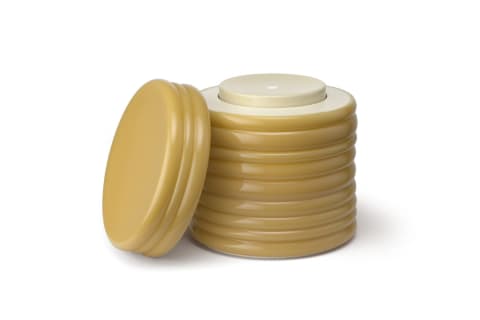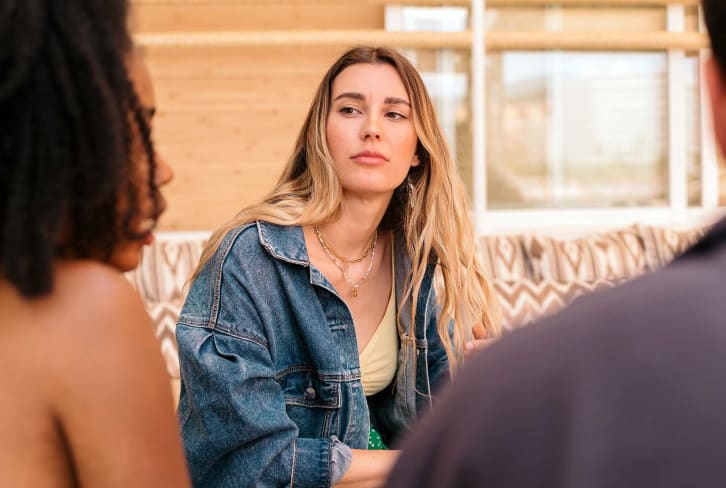
Image by Miri Rodriguez / mbg Creative
November 26, 2022
Our editors have independently chosen the products listed on this page. If you purchase something mentioned in this article, we may
While some health issues are visible to the outside world, many people face chronic conditions that don’t have externally visible signs or symptoms—also known as invisible illnesses. In mindbodygreen’s series, we’re giving individuals with invisible illnesses a platform to share their personal experiences. Our hope is their stories will shed light on these conditions and offer solidarity to others facing similar situations.
I was waiting in the green room at a marketing conference, minutes before I was expected to go onstage to deliver a keynote when I suddenly felt a gush of blood go down my leg. Shocked and confused because I had just completed a menstrual cycle, I quickly cleaned it up, feeling grateful I’d chosen to wear a red dress that day. After my speaking engagement ended, I returned backstage hoping the mysterious bleeding had stopped. But it didn’t. I continued to bleed outside of my menstrual cycle for the next four years.
Advertisement
This ad is displayed using third party content and we do not control its accessibility features.
I spent years searching for answers.
At first, I thought the unexplained bleeding was a period breakthrough, but as time went by, it became clear that this was much more. Doctors couldn’t figure out what was causing it—they did a number of tests, but the results always came back “normal.” Ultimately, they chalked it up to stress.
A couple of years later, I moved to Seattle for a new job and ended up seeking out an alternative medicine doctor. After running even more tests, she noted my testosterone levels were low, which could potentially explain my irregular period. To remedy this imbalance, I started hormone replacement therapy. The bleeding got better, but it didn’t go away entirely.
Then, COVID hit. My family and I decided to go back to Miami to be closer to our extended family. I had to check in with a local doctor because I was still in the process of my hormone replacement treatment. I was asked the regular new patient intake questions including: Do you have a family history of cancer? My answer was always no. But when I told this doctor I’d been bleeding for four years, she became concerned and asked if it’d be OK that she run additional tests on me, including a genetics test.
Through these tests, my doctor found a couple of cysts in my uterus and ovaries, which she recommended removing, so she scheduled a follow-up call to discuss surgical plans.
“Are you sitting down?”
She asked kindly.
I wasn’t. I was running around the house trying to multitask. She asked me to find a comfortable place to sit down.
“I cannot perform the surgery. You tested positive for BRCA1.”
I didn’t hear anything she said after that. All I remember is there was this overwhelming ringing in my ears, just like in the movies. I started to transcribe all the information she was giving me on a notepad almost on autopilot, without really processing it.
Later, the information sunk in: Everyone with the BRCA1 gene has a different, elevated probability of getting breast or ovarian cancer depending on their family history. Based on my results, I had an 87% chance of getting ovarian cancer and likely already had it based on my incessant bleeding. I was quickly referred to an oncologist and a genetics counselor.
The counselor informed me that I may not be the only one in my family affected by this dreadful gene mutation. In fact, this mutation does not skip generations! I had inherited this from one of my parents, and both of my sons now have a 50% chance of also inheriting it and passing it on.
Up until this point, I had never considered that “family history of cancer” didn’t just mean a cancer diagnosis for someone in my immediate family. It meant thoroughly understanding my ancestry and DNA makeup.
I began the mind-depleting task of not only sharing the news of my recent diagnosis with each of my aunts, uncles, and cousins on both sides of my family but also begging them to get tested, as they, too, could be victims of this condition. I learned that every one of my dad’s seven sisters had a terrible history with their menstrual cycles, and five of them had hysterectomies in their 40s; two were already deceased. Imagine my shock. Imagine how knowing this information at the onset of my bleeding could have changed my outcomes. It would have probably saved me months of unnamed emotional and physical pain. I never thought about talking to my aunts or cousins about my irregular bleeding because women rarely talk about these things. It seems too personal. You just don’t go around asking people in your family if they’ve had issues with their reproductive systems.
But…why not?
Intuition played a big role in my recovery.
After speaking to my family members and further educating myself on BRCA mutation, I leaned into my intuition for the next steps. For me, it was important to let my own voice guide me in this situation—what did I need to do next? Immediately, I started to interview several doctors because I was going to need a whole team to work together: a general oncologist; an oncologist gynecologist; a breast oncologist; and, if I decided to take proactive measures with my breasts, I’d also need a breast surgeon and plastic surgeon. Through this process of interviewing doctor after doctor, I found my voice. Each interview gave me more confidence in what I wanted and needed from physicians. I showed up full of questions and determined to choose who would partner with me on this journey. They were experts in their field, but I was the expert of my body. And this became my fight.
Advertisement
This ad is displayed using third party content and we do not control its accessibility features.
Women have so much to fight for, but sometimes we forget to fight for ourselves.
It’s important to note that, while there are some tests for ovarian cancer—including a transvaginal ultrasound (TVUS) and the CA-125 blood test—unfortunately, none of these are considered reliable ways for early ovarian cancer detection.
With my history of four years of bleeding along with my genetics test, there was a chance there was cancer already in my ovaries. So having a full hysterectomy was the first (and urgent) order of business. And so we scheduled the surgery.
However, the breast surgeon called me randomly one morning.
“I couldn’t sleep last night thinking of you. I want to do an MRI on your breasts.”
This was odd to me since my routine mammograms and sonograms had come back negative. But I understood; she, too, was leading with her intuition.
The MRI detected abnormalities, so doctors performed a biopsy that confirmed I’d developed stage zero cancer, the earliest form, in both breasts. If I’d waited a year, who knows what may have happened? Having the gene mutation means the cancer could metastasize fast.
So in August of last year, I had a lumpectomy and hysterectomy. Then, in September, I was able to opt for a nipple-sparing procedure, before my eventual double mastectomy this past July. This is a new technology that enabled the surgeons to use my own nipples during breast reconstruction—something that would have been too risky if the cancer had already spread.
When you go through a procedure like this, there’s a sense of mourning for your body, so I’m really grateful I had this option.
Why I believe it’s so important to be your own advocate.
I’m so thankful for everything my doctors have done throughout my health journey, and now I understand how critically important it is to work with doctors you can partner with. Beyond that, it’s also crucial to understand and become the expert of your own body. You can advocate for yourself, you can push back, you can ask for additional tests.
I think as women, we don’t always consider that we have that power. For Latina women, especially, a man in a white coat carries a sense of authority and respect that you don’t question.
Women have so much to fight for, but sometimes we forget to fight for ourselves.
Self-advocacy saved my life. I chose doctors who partnered with me. Who were intimately involved in my journey. I didn’t just wait for a doctor to tell me what to do. I communicated what I needed, how I needed them to partner with me. I chose one of the doctors for my team because when he first met with me, he sat down next to me and said: “Tell me what you want to do. What’s your plan? How can I help you?” That was so powerful.
Advertisement
This ad is displayed using third party content and we do not control its accessibility features.
How I’m advocating for other women.
I’ve been doing mindfulness work for 10 years, but during my health journey, it became especially important in my life. I prioritized holistic wellness work to align my mind and body, and it helped me prepare for and recover from the various surgeries and procedures I had to go through.
Since I found this work so beneficial for my own journey, I wanted to share it with other women too. During one of my recoveries, I purchased Be Mindful, Be Happy, a wellness brand led by women, which provides a space to talk about mindfulness and holistic well-being.
I also developed a self-care curriculum called “Learn. Like. Love.” which focuses on these same principles. Some of the key points I discuss are about learning who you are, learning how your body works, what makes you happy, how to create boundaries—it’s a lot of introspective work. From there, I discuss liking who you’re becoming and not being apologetic about it. Then, we focus on loving ourselves and others at the same time.
In addition to this work, I’m a big proponent of sharing my story and experience, to hopefully help educate and share information with other women. Because of my journey, I encourage others to get a genetics test or any other test they feel they may need beyond the routine checkups. I believe that’s the one thing you do have control over.
Ultimately, the biggest message I try to share with other women is: Know what you want to fight for, and awaken your inner warrior.
Advertisement
This ad is displayed using third party content and we do not control its accessibility features.









